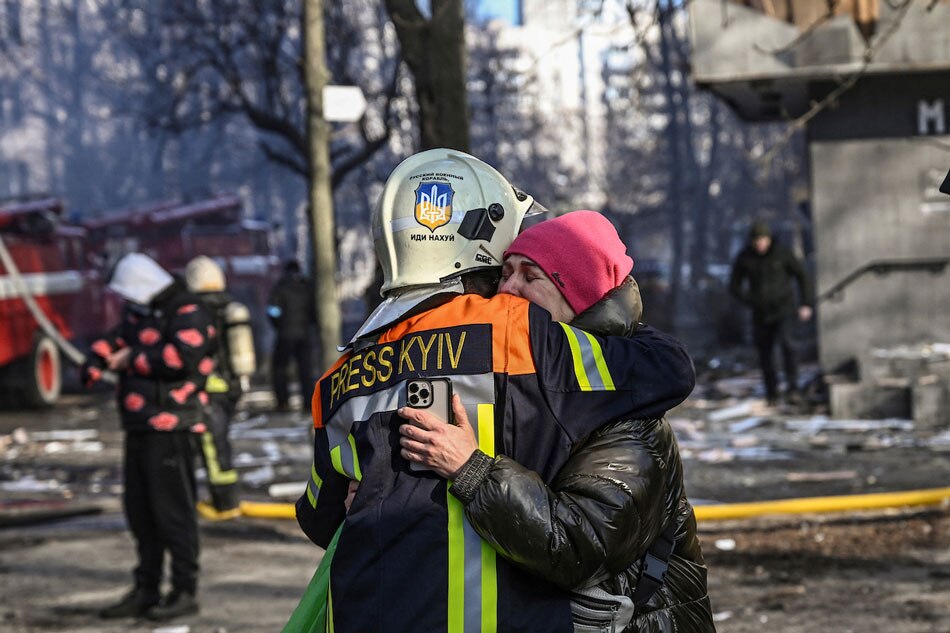One year of Ukraine war: Why we get compassion fatigue | ABS-CBN
ADVERTISEMENT

Welcome, Kapamilya! We use cookies to improve your browsing experience. Continuing to use this site means you agree to our use of cookies. Tell me more!
One year of Ukraine war: Why we get compassion fatigue
One year of Ukraine war: Why we get compassion fatigue
Deutsche Welle
Published Feb 24, 2023 12:08 PM PHT
It's easy to turn away from another news article or social media post about war and violence. After all, we're constantly bombarded with images of traumatic events when we're online.
It's easy to turn away from another news article or social media post about war and violence. After all, we're constantly bombarded with images of traumatic events when we're online.
The phenomenon, known as compassion fatigue, or empathy burnout, causes us to lose our capacity to react and help those in need.
The phenomenon, known as compassion fatigue, or empathy burnout, causes us to lose our capacity to react and help those in need.
"I felt this after the invasion of Ukraine," said Jessica Roberts, an assistant professor of communication studies at the Universidade Catolica Portuguesa in Lisbon. "When I first heard about the atrocities it was horrifying, but then I heard about another town and my reaction was less extreme."
"I felt this after the invasion of Ukraine," said Jessica Roberts, an assistant professor of communication studies at the Universidade Catolica Portuguesa in Lisbon. "When I first heard about the atrocities it was horrifying, but then I heard about another town and my reaction was less extreme."
Compassion fatigue does not have to be permanent. As Susan Sontag wrote in her 2003 essay "Regarding the Pain of Others": "Compassion is an unstable emotion. It needs to be translated into action, or it withers."
Compassion fatigue does not have to be permanent. As Susan Sontag wrote in her 2003 essay "Regarding the Pain of Others": "Compassion is an unstable emotion. It needs to be translated into action, or it withers."
ADVERTISEMENT
So just how can we translate compassion into action? Here we take a look at how compassion can both fatigue and be rebuilt.
So just how can we translate compassion into action? Here we take a look at how compassion can both fatigue and be rebuilt.
Compassion fatigue and violence numbness
Brad Bushman, a media researcher at Ohio State University in the US, has conducted experiments illustrating how violence in digital media formats like video games and films can desensitize people's responses to suffering or violence in real life.
Brad Bushman, a media researcher at Ohio State University in the US, has conducted experiments illustrating how violence in digital media formats like video games and films can desensitize people's responses to suffering or violence in real life.
In one study, Bushman and his colleagues had 320 students play either a violent or nonviolent video game for 20 minutes. After playing, participants were instructed to answer a questionnaire, but during this time they heard a fight break out in the hallway outside.
In one study, Bushman and his colleagues had 320 students play either a violent or nonviolent video game for 20 minutes. After playing, participants were instructed to answer a questionnaire, but during this time they heard a fight break out in the hallway outside.
"In reality this was a recording of professional actors having a fight. We also had a research assistant outside the room kick a trash can and start groaning," Bushman told DW.
"In reality this was a recording of professional actors having a fight. We also had a research assistant outside the room kick a trash can and start groaning," Bushman told DW.
They then measured how long it took participants to help the groaning assistant. On average, it took people who played the nonviolent game 16 seconds, whereas those who played the violent game took 73 seconds.
They then measured how long it took participants to help the groaning assistant. On average, it took people who played the nonviolent game 16 seconds, whereas those who played the violent game took 73 seconds.
ADVERTISEMENT
What's more, said Bushman, those who played the violent video game reported the fight to be less serious than those who played the nonviolent game.
What's more, said Bushman, those who played the violent video game reported the fight to be less serious than those who played the nonviolent game.
It would be too simple to conclude here that violent video games cause violence, but in Bushman's experiments, they did appear to temporarily change people's responses to violence in the real world.
It would be too simple to conclude here that violent video games cause violence, but in Bushman's experiments, they did appear to temporarily change people's responses to violence in the real world.
"The consequence of seeing violent images is that you become numb to it and you think violence is no big deal. The real-world consequences are that you're less likely to help someone who's a victim of violence," said Bushman.
"The consequence of seeing violent images is that you become numb to it and you think violence is no big deal. The real-world consequences are that you're less likely to help someone who's a victim of violence," said Bushman.
Compassion fatigue is a form of emotional protection
According to Bushman, the underlying psychological mechanism behind compassion fatigue is desensitization.
According to Bushman, the underlying psychological mechanism behind compassion fatigue is desensitization.
"Really, it's a kind of emotional or attentional filtering that protects us from suffering becoming too stressful or traumatic to cope with," said Bushman.
"Really, it's a kind of emotional or attentional filtering that protects us from suffering becoming too stressful or traumatic to cope with," said Bushman.
ADVERTISEMENT
It's also possible to detect desensitization to violent images in people's physiological responses to stress.
It's also possible to detect desensitization to violent images in people's physiological responses to stress.
"If you measure peoples cardiovascular arousal responses or startle brain waves (using electroencephalography), you see that people's physiological shock responses to violent images are dampened in those people who've just been playing a violent video game," said Bushman.
"If you measure peoples cardiovascular arousal responses or startle brain waves (using electroencephalography), you see that people's physiological shock responses to violent images are dampened in those people who've just been playing a violent video game," said Bushman.
But, he argued, desensitization to violence and trauma can be an important adaptive strategy for people whose work involves frequent exposure to traumatic events, like soldiers, aid workers and doctors.
But, he argued, desensitization to violence and trauma can be an important adaptive strategy for people whose work involves frequent exposure to traumatic events, like soldiers, aid workers and doctors.
The problem arises when this desensitization is detected in the "ordinary" population.
The problem arises when this desensitization is detected in the "ordinary" population.
"This adaptation is one of the mechanisms that actually drives further aggression and violence in society," said Bushman, referring to research showing how conflict in Israel and Palestine escalates violence in children.
"This adaptation is one of the mechanisms that actually drives further aggression and violence in society," said Bushman, referring to research showing how conflict in Israel and Palestine escalates violence in children.
ADVERTISEMENT
Compassion fatigue toward refugees
Yasmin Aldamen, at Ibn Haldun University in Istanbul, emphasized the dangers of how compassion fatigue can lead to greater violence and hate speech in society. Aldamen's research focuses on the impact compassion fatigue and negative media representations have on Syrian refugees in Turkey and Jordan.
Yasmin Aldamen, at Ibn Haldun University in Istanbul, emphasized the dangers of how compassion fatigue can lead to greater violence and hate speech in society. Aldamen's research focuses on the impact compassion fatigue and negative media representations have on Syrian refugees in Turkey and Jordan.
"We found that framing negative images and messages of refugees in the media opens the door for audiences to lose empathy for them or even have hatred for refugees," Aldamen told DW.
"We found that framing negative images and messages of refugees in the media opens the door for audiences to lose empathy for them or even have hatred for refugees," Aldamen told DW.
Sadly, this is not new or surprising. Violence toward refugees and migrants has existed as long as humans have fled conflict and been transplanted. But what is new is how quickly media and social media can drive compassion fatigue and subsequent hate speech and racism.
Sadly, this is not new or surprising. Violence toward refugees and migrants has existed as long as humans have fled conflict and been transplanted. But what is new is how quickly media and social media can drive compassion fatigue and subsequent hate speech and racism.
It's something we see time and time again, after refugees fleeing the Taliban takeover of Afghanistan, with the crisis in Ukraine and with refugees fleeing conflict and climate change in North Africa.
It's something we see time and time again, after refugees fleeing the Taliban takeover of Afghanistan, with the crisis in Ukraine and with refugees fleeing conflict and climate change in North Africa.
"There's evidence showing that people give less aid money after a disaster over time. It's already happening with the earthquake in Turkey and Syria," said Roberts of Universidade Catolica Portuguesa.
"There's evidence showing that people give less aid money after a disaster over time. It's already happening with the earthquake in Turkey and Syria," said Roberts of Universidade Catolica Portuguesa.
ADVERTISEMENT
Compassion fatigue is temporary and can be reversed
Compassion fatigue can be reversed, according to Roberts and Aldamen. They say you can rebuild your capacity for compassion over time.
Compassion fatigue can be reversed, according to Roberts and Aldamen. They say you can rebuild your capacity for compassion over time.
"We can use social media to create empathy and compassion between people. In our research, we looked at Humans of New York, where a guy focused on the positive and relatable stories of people's lives, instead of their trauma. It helped to create great empathy, " Roberts told DW.
"We can use social media to create empathy and compassion between people. In our research, we looked at Humans of New York, where a guy focused on the positive and relatable stories of people's lives, instead of their trauma. It helped to create great empathy, " Roberts told DW.
Aldamen has a similar mission. She is calling for media outlets and people on social media to change the way they represent refugees and other vulnerable populations.
Aldamen has a similar mission. She is calling for media outlets and people on social media to change the way they represent refugees and other vulnerable populations.
"My study recommends reporting of the Syrian refugee crisis (and other crises) from a more humanistic perspective. Media outlets need to display some of the more positive stories from the refugee crisis to ensure that people do not suffer compassion fatigue to exposure to tragic stories," Aldamen told DW.
"My study recommends reporting of the Syrian refugee crisis (and other crises) from a more humanistic perspective. Media outlets need to display some of the more positive stories from the refugee crisis to ensure that people do not suffer compassion fatigue to exposure to tragic stories," Aldamen told DW.
She also said it's important for news articles to involve calls to action on individuals or policymakers so readers can help those in need rather than observing a crisis they feel cannot be solved.
She also said it's important for news articles to involve calls to action on individuals or policymakers so readers can help those in need rather than observing a crisis they feel cannot be solved.
ADVERTISEMENT
Here's how to donate to earthquake aid efforts in Turkey and Syria.
Here's how to donate to earthquake aid efforts in Turkey and Syria.
Edited by: Clare Roth
ADVERTISEMENT
ADVERTISEMENT



